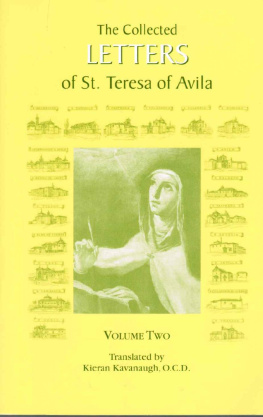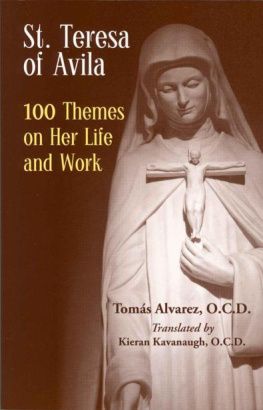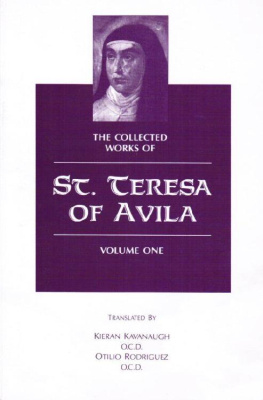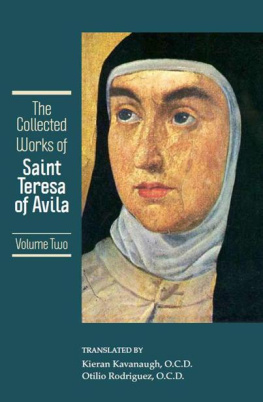St. Teresa of Avila - The Interior Castle (with Supplemental Reading: Catholic Prayers) [Illustrated]
Here you can read online St. Teresa of Avila - The Interior Castle (with Supplemental Reading: Catholic Prayers) [Illustrated] full text of the book (entire story) in english for free. Download pdf and epub, get meaning, cover and reviews about this ebook. year: 2013, publisher: TAN Books, genre: Religion. Description of the work, (preface) as well as reviews are available. Best literature library LitArk.com created for fans of good reading and offers a wide selection of genres:
Romance novel
Science fiction
Adventure
Detective
Science
History
Home and family
Prose
Art
Politics
Computer
Non-fiction
Religion
Business
Children
Humor
Choose a favorite category and find really read worthwhile books. Enjoy immersion in the world of imagination, feel the emotions of the characters or learn something new for yourself, make an fascinating discovery.

- Book:The Interior Castle (with Supplemental Reading: Catholic Prayers) [Illustrated]
- Author:
- Publisher:TAN Books
- Genre:
- Year:2013
- Rating:3 / 5
- Favourites:Add to favourites
- Your mark:
- 60
- 1
- 2
- 3
- 4
- 5
The Interior Castle (with Supplemental Reading: Catholic Prayers) [Illustrated]: summary, description and annotation
We offer to read an annotation, description, summary or preface (depends on what the author of the book "The Interior Castle (with Supplemental Reading: Catholic Prayers) [Illustrated]" wrote himself). If you haven't found the necessary information about the book — write in the comments, we will try to find it.
The Interior Castle (with Supplemental Reading: Catholic Prayers) [Illustrated] — read online for free the complete book (whole text) full work
Below is the text of the book, divided by pages. System saving the place of the last page read, allows you to conveniently read the book "The Interior Castle (with Supplemental Reading: Catholic Prayers) [Illustrated]" online for free, without having to search again every time where you left off. Put a bookmark, and you can go to the page where you finished reading at any time.
Font size:
Interval:
Bookmark:

Imprimatur: Edward
Edward
Apostolic Minister
Birmingham, Oscott
February 24, 1921
Nihil Obstat:
Dom Michael Barrett, O.S.B.
Censor Deputatus

Copyright 2011 Saint Benedict Press, TAN Books.
TAN Books is an imprint of Saint Benedict Press, Charlotte, North Carolina.
This translation first published in approximately 1912. This edition published in 1997 by TAN Books and Publishers, Inc., by arrangement with the Benedictines of Stanbrook, being photographically reproduced from the Third Edition with Additional Notes published by Thomas Baker, London, in 1921. Typeset and published by Saint Benedict Press, TAN Books, in 2011.
Published with the assistance of The Livingstone Corporation. Cover and interior design by Mark Wainright, The Livingstone Corporation. Typeset by Saint Benedict Press, TAN Books.
Library of Congress Catalog Card No.: 9760909
ISBN: 978-0-89555-227-3
Cover image: Ecstasy of St. Theresa (marble), Bernini, Giovanni Lorenzo (1598-1680), Santa Maria della Vittoria, Rome, Italy. The Bridgeman Art Library International.
Printed and bound in United States of America.
10 9 8 7 6 5 4 3 2 1
www.tanbooks.com
www.saintbenedictpress.com

DEDICATED TO
The Martyred Daughters of St. Teresa,
The Blessed Martyrs of Compiegne, France,
by the Descendants of Their Fellow Prisoners.
Stanbrook Abbey
Day of Beatification
May 27, 1906
The Benedictines of Stanbrook desire to express their gratitude
to the Very Rev. Benedict Zimmerman for having kindly revised the
translation of the Interior Castle and also for the Introduction,
Notes, and Index which he has added to the book.
CONTENTS
Description of the Castle
The Human Soul
War
Fear of God
Aridity in Prayer
Sweetness in Prayer
Divine Consolations
Prayer of Quiet
Prayer of Union
Effects of Union
Cause of Union
Spiritual Espousals
Preparation for Spiritual Marriage
The Wound of Love
Locutions
Raptures
The Flight of the Spirit
Spiritual Jubilation
The Humanity of Our Lord
Intellectual Visions
Imaginary Visions
Intellectual Visions continued
The Dart of Love
Gods Presence Chamber
Spiritual Marriage
Its Effects
Martha and Mary
NOTE
I N THIS new edition the wording has been revised and condensed, chiefly with a view to rendering the translation more pregnant. Only one passage (VI. Mansion, ch. v. 13) has been substantially changed, in conformity with an explanation received from a high authority. It is admittedly a very difficult passage which appears to have been misunderstood by nearly all translators; but it is gratifying to notice that the new French translation by the Carmelite nuns of Anderlecht agrees with our interpretation. The editor is under an obligation to that translation for several interesting facts embodied in the Introduction and in the notes to the text.
B. Z. Wincanton
December 25, 1911
INTRODUCTION
S AINT TERESA began to write the Interior Castle on June 2, 1577, Trinity Sunday, and completed it on the eve of St. Andrew, November 29, of the same year. But there was a long interruption of five months, The Saint was not in good health at the time; she repeatedly complains of noises in the head and other infirmities, but, worst of all, she was weighed down by troubles and anxieties resulting from the action of the superiors of the Order and of the Papal Nuncio against the nuns and friars of the Reform. Matters became even more serious when, in October, the nuns of the Incarnation of Avila proceeded to the election of a new prioress. Notwithstanding the prohibition of the provincial, fifty-five electors recorded their votes in favor of the Saint and were immediately declared excommunicated. The whole work of the Reform seemed on the brink of ruin, the Saint, as well as all her friends, was in disgrace, subject to obloquy and ill treatment.
No trace of these trials is to be found in the Interior Castle. Saint Teresa possessed the power of concentration of thought in a marvellous degree. The early mornings and late evenings were devoted to the composition of the book, while the rest of the day was taken up by the affairs of the Order. Mother Mary of the Nativity, a member of the community of Toledo, where the book was begun, declared afterwards, reports having heard from the same witness, that entering her cell one day to deliver a message, the holy Mother was just beginning a new sheet of her book. While taking off her spectacles to listen to the message she was seized by a trance in which she remained for several hours. The nun, terrified at this, did not stir, but kept her eyes steadily on the Saint. When she came to, it was seen that the paper, previously blank, was covered with writing. Noticing that her visitor had discovered it, Saint Teresa put the paper quietly in the box.
Another nun, Mary of St. Francis, left the following declaration: I know that our holy Mother wrote four books, the Life, the Way of Perfection, the Foundations, and the Mansions, which I have seen her writing. Once, while she was composing the lastnamed work, I entered to deliver a message, and found her so absorbed that she did not notice me; her face seemed quite illuminated and most beautiful. After having listened to me she said: Sit down, my child, and let me write what Our Lord has told me ere I forget it, and she went on writing with great rapidity and without stopping.
Mary of St. Joseph says she heard from Mary of the Nativity that Father Jerome Gracian commanded the Saint to write the Mansions; she, however, begged to be excused, because so many books having been written by holy and learned men, there remained nothing for a woman to write. At length she yielded under obedience. This nun (Mary of the Nativity) was frequently in the Saints cell while she was writing and she noticed her resplendent face and the almost preternatural velocity with which her hand travelled over the paper.
Writing to Mother Mary of St. Joseph, Prioress of Seville, November 8, 1581, St. Teresa gives her a message for Father Rodrigo Alvarez, S.J.: Our Father (Jerome Gracian, then provincial) tells me that he has handed you a book written by me, which perhaps you do not feel inclined to read yourself. Kindly read to Father Rodrigo Alvarez, at his next visit, the last Mansion, but under the seal of Confession, as he asks this in his superior wisdom. This is only for you two. Tell him that the person he knows has arrived at this Mansion and enjoys the peace there described; that she is entirely at rest, and that some grave theologians have assured her that she is on a safe road. In case you could not read these pages to him do not send him the book, for it might lead to unpleasantness. Until I have his answer on this matter I will not write to him. Give him my compliments.
At the end of the original manuscript, before the epilogue (marked with Ihs.) there is a notice in Father Alvarez handwriting to this effect: The Mother Prioress of the convent of Seville has read to me this seventh Mansion, whither a soul may arrive in the present life. Let all the saints praise the infinite goodness of God, Who communicates Himself to His creatures so that they truly seek His glory and the salvation of their neighbor. What I feel and judge of this matter is, that everything that has been read to me is conformable to Catholic truth and in accordance with Holy Scripture and the teaching of the Saints. Whosoever has read the doctrine of the Saints, such as the books of St. Gertrude, St. Catharine of Siena, or St. Bridget of Sweden, and other saints and spiritual writers, will clearly understand that the spirit of Mother Tireza (sic ) of Jesus is true, since it leads to the same effects as are to be found in the Saints; and because this is in truth my judgment and opinion, I have hereunto set my name, this, the 22nd day of February, 1582. P. Rodrigo Alvarez.
Next pageFont size:
Interval:
Bookmark:
Similar books «The Interior Castle (with Supplemental Reading: Catholic Prayers) [Illustrated]»
Look at similar books to The Interior Castle (with Supplemental Reading: Catholic Prayers) [Illustrated]. We have selected literature similar in name and meaning in the hope of providing readers with more options to find new, interesting, not yet read works.
Discussion, reviews of the book The Interior Castle (with Supplemental Reading: Catholic Prayers) [Illustrated] and just readers' own opinions. Leave your comments, write what you think about the work, its meaning or the main characters. Specify what exactly you liked and what you didn't like, and why you think so.






